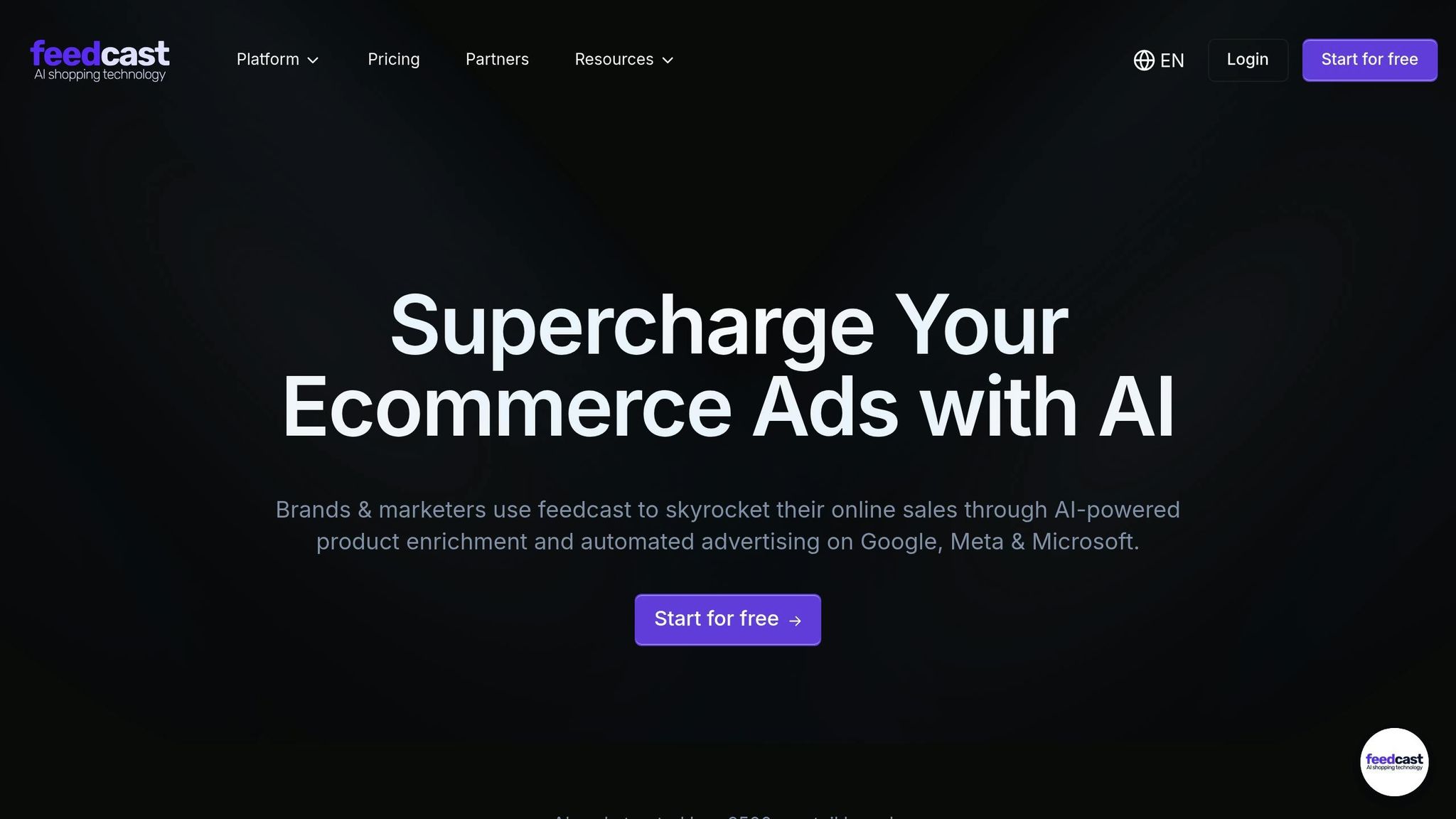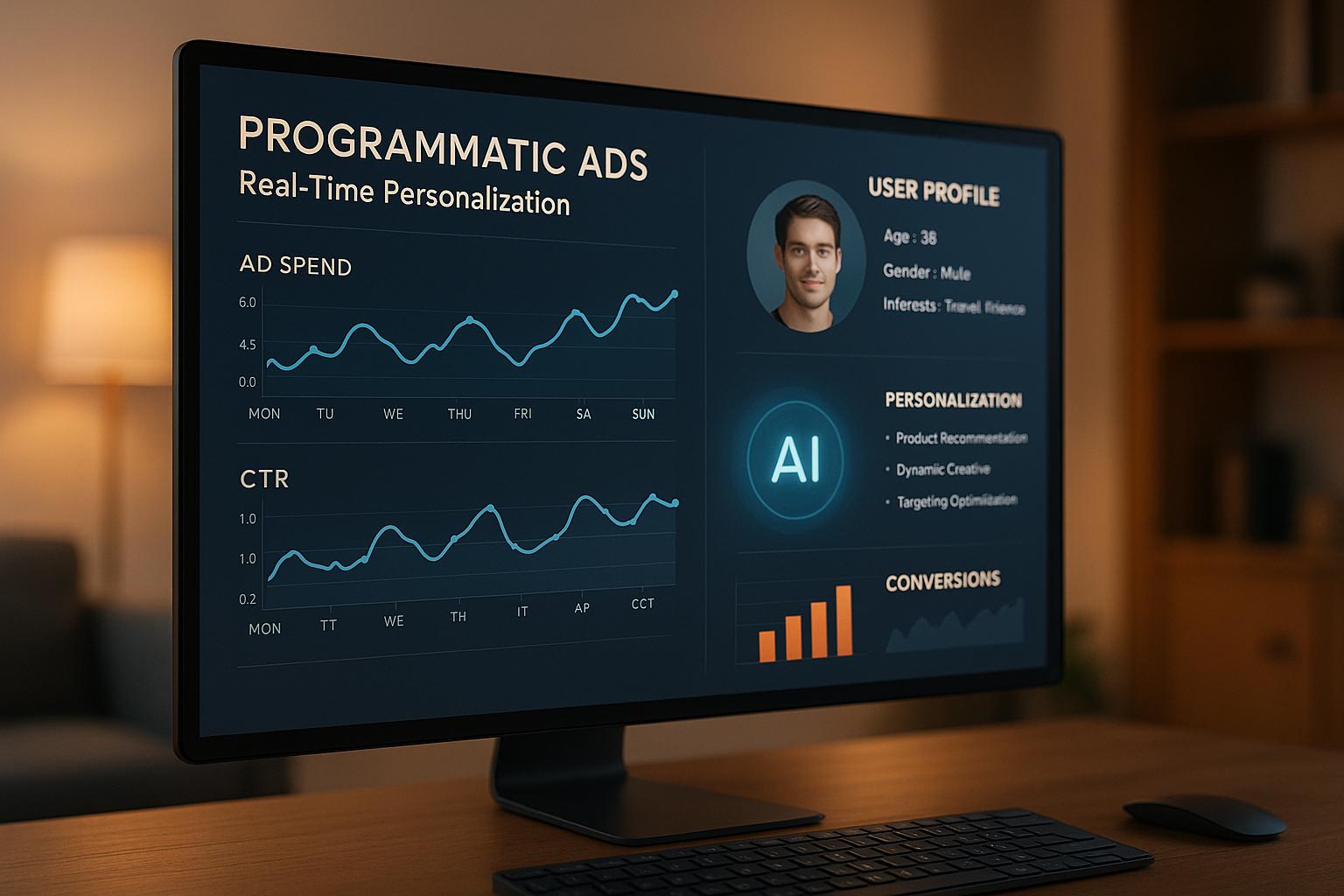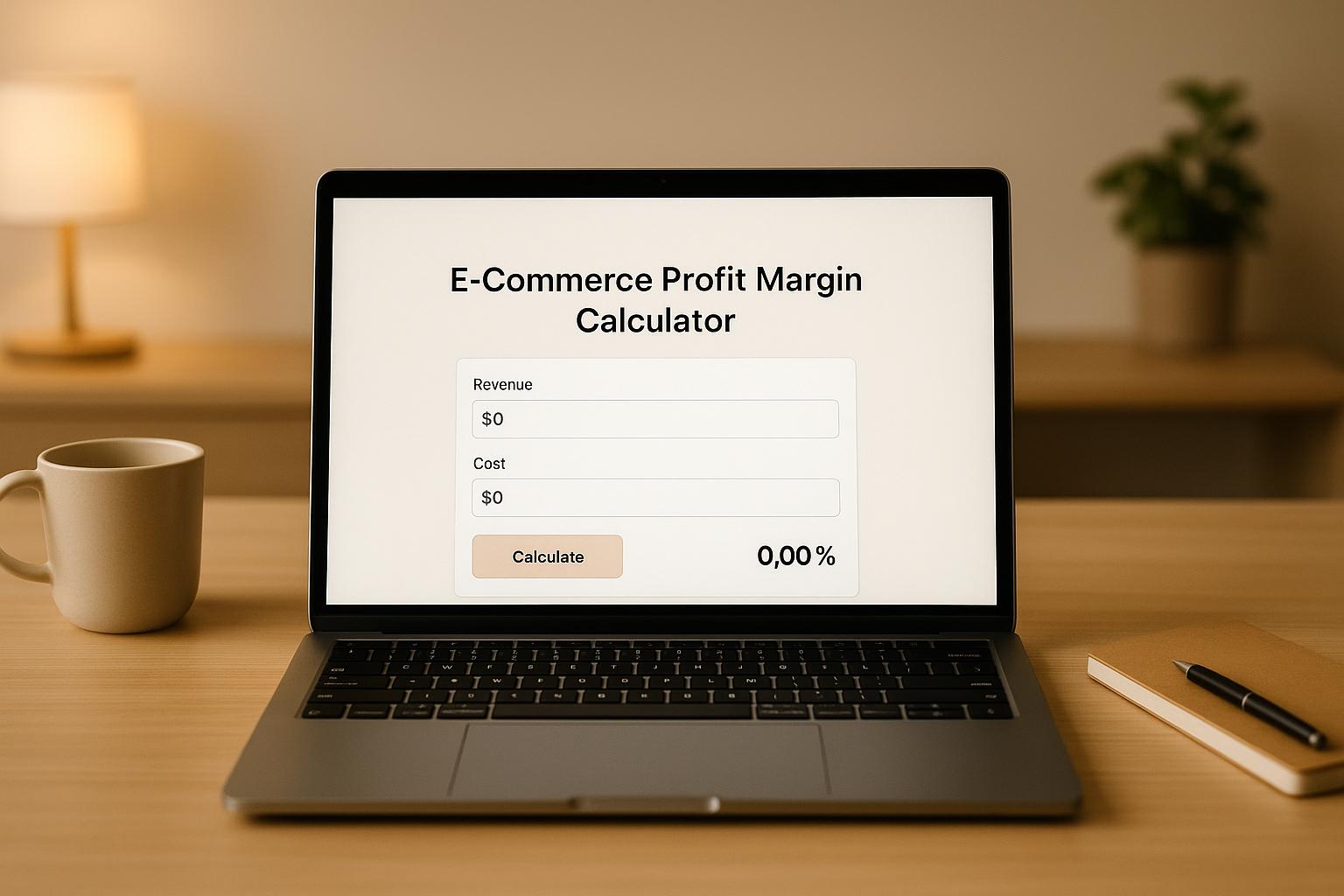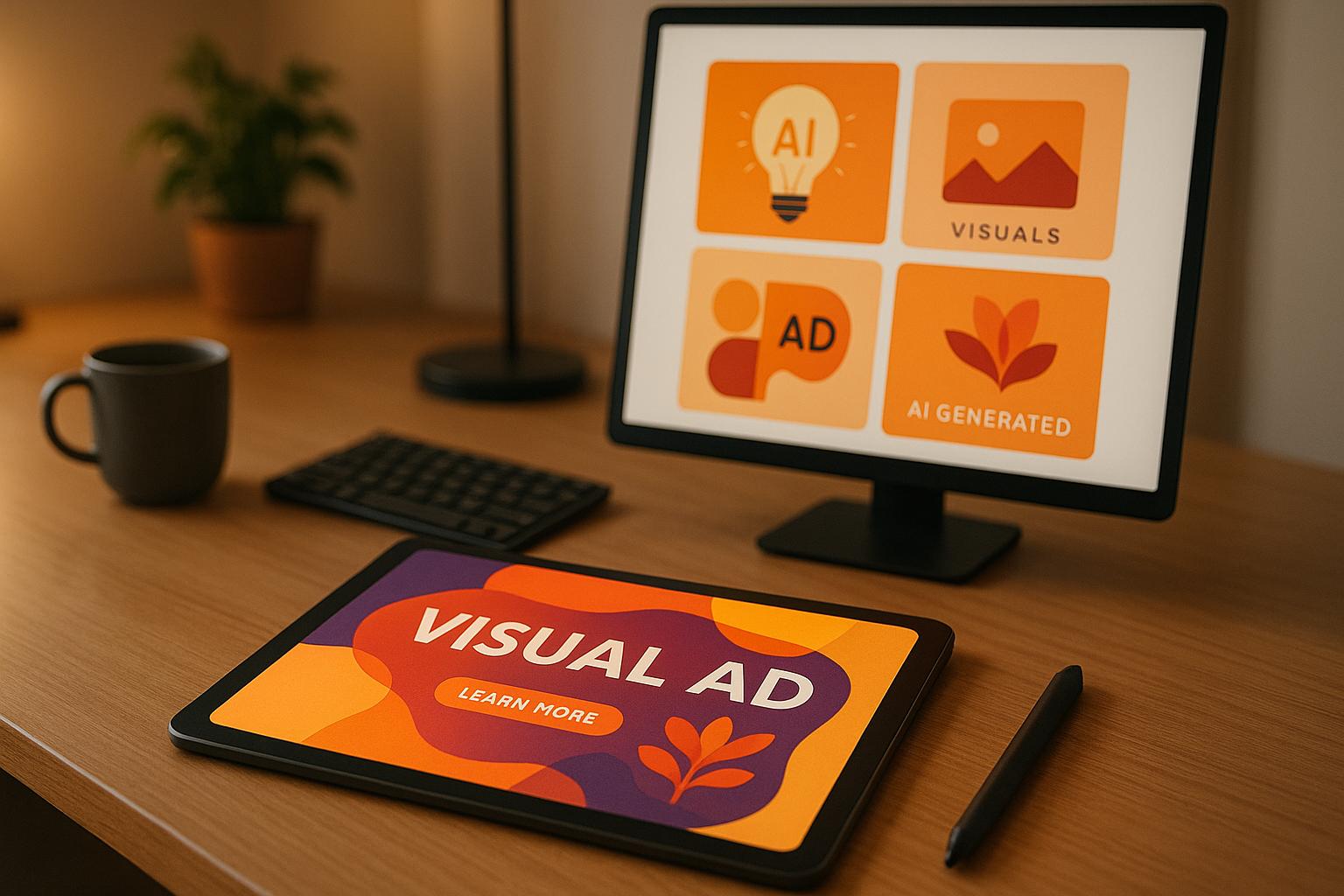Real-Time Ad Customization with AI: How It Works
Real-time ad customization uses AI to tailor ads to individuals instantly. It adjusts visuals, messages, and offers based on user behavior, location, and preferences - all in milliseconds. This approach increases engagement, boosts conversions, and optimizes ad spend by showing the most relevant content to each user.
Key technologies include:
- Machine Learning: Predicts user preferences and refines ad targeting.
- Computer Vision: Adjusts visuals based on user data and trends.
- Natural Language Processing (NLP): Crafts personalized ad copy.
- Real-Time Data Processing: Updates ads instantly using fresh insights.
Platforms like Feedcast.ai simplify this process by managing campaigns, optimizing product feeds, and automating creative assets. While this strategy requires high-quality data and initial setup, it helps businesses scale efficiently, reduce costs, and deliver better results.
Want to get started? Focus on cleaning your product data, choosing scalable tools, and testing small campaigns before expanding.
Hyper Personalized Advertising with Generative AI in Python: Implementation and Techniques
Core AI Technologies for Real-Time Ad Customization
Real-time customized ads rely on a well-coordinated blend of AI technologies. These systems analyze massive amounts of data and adapt ads instantly, creating experiences that feel almost intuitive. By understanding these technologies, e-commerce businesses can better shape their advertising strategies.
Machine Learning and Predictive Analytics
Machine learning is the backbone of real-time ad customization. It analyzes user behavior and purchase history to predict which products or messages will resonate with each individual.
What makes machine learning so effective is its ability to learn from every interaction. It identifies patterns in user behavior and applies those insights to others with similar profiles. These predictions directly influence visual aspects of ads, often in tandem with computer vision tools.
Predictive analytics expands on this by forecasting future behavior. For instance, it might detect that users browsing specific categories over the weekend are more likely to make purchases early in the week. This insight allows businesses to time their ads for maximum impact.
Additionally, these models can create highly specific user segments. Instead of relying on broad demographics, machine learning builds detailed profiles based on lifestyle choices, shopping habits, and even mobile usage trends.
Computer Vision for Visual Customization
Computer vision takes ad visuals to the next level. This AI technology analyzes images, identifies objects, and understands visual contexts to create highly relevant ad visuals.
For example, computer vision can automatically generate product images with different backgrounds, lighting, or styles to match the preferences of specific user groups. If data shows that a particular audience prefers minimalist designs with clean, white backgrounds, the system adjusts accordingly.
It also adapts visuals based on seasonal trends or user preferences, such as modifying imagery to reflect current weather or style shifts. This ensures that ads stay relevant and appealing, no matter the context.
Natural Language Processing for Ad Copy
Natural Language Processing (NLP) shapes the words that sell. By understanding context, sentiment, and language patterns, NLP generates ad copy that feels personal and engaging.
NLP systems study how different audiences react to various messaging styles. Some users might prefer detailed product descriptions, while others respond better to emotional storytelling or urgency-driven language. The system customizes the messaging so that it resonates with each user.
It also tailors language to local expressions and user sentiment. For example, if someone has been browsing budget-friendly options, the ad might emphasize savings and value. On the other hand, users exploring premium products might see messaging focused on luxury and quality. Sentiment analysis ensures that the tone matches the user's mindset.
Real-Time Data Processing
Real-time data processing is the glue that holds everything together. This system handles user data in milliseconds, enabling instant ad personalization.
It continuously collects data from multiple sources - website activity, social media, purchase history, location, and device information. Stream processing ensures that user profiles are updated in real time, providing a constant flow of fresh insights.
Edge computing plays a crucial role by reducing delays, ensuring ads are delivered swiftly. Data pipelines connect the various AI systems, allowing machine learning insights to shape visuals through computer vision or adjust messaging via NLP.
During high-traffic events like Black Friday, this infrastructure shines. It manages massive volumes of ad requests without compromising personalization, thanks to load balancing and distributed computing. Even during peak times, users enjoy seamless, tailored ad experiences.
Together, these core technologies - machine learning, computer vision, NLP, and real-time data processing - work in harmony to create dynamic, personalized ads. Their strength lies in their ability to continuously learn and adapt, ensuring every interaction improves the next.
Tools and Platforms for Real-Time Ad Customization
To make AI-driven ad personalization work at scale, you need the right tools. This includes platforms for managing multichannel campaigns, creative automation tools, and feed optimization systems. Let’s break down how tools like Feedcast.ai and creative automation software bring these capabilities to life.
Feedcast.ai for Multichannel Ad Management

Feedcast.ai combines AI-enhanced product data with streamlined campaign management to deliver personalized ads efficiently. It simplifies the process of creating and managing tailored ads across multiple platforms.
One of its standout features is AI-powered product enrichment, which upgrades product titles, descriptions, and attributes automatically. This feature analyzes your existing product data, adds relevant keywords, and improves descriptions to boost visibility and performance - all without manual effort. Essentially, it makes your product listings more appealing while saving you time.
Another key feature is unified campaign management, which allows you to connect ad accounts from platforms like Google, Meta (Facebook and Instagram), and Microsoft Ads into one central dashboard. This setup ensures consistent personalization while enabling platform-specific adjustments.
Real-time tracking through a unified dashboard provides instant insights into how your ads are performing. You can quickly identify which strategies resonate with different audience segments and tweak your approach on the fly. The platform also offers custom reporting and performance segmentation, giving you a detailed look at your campaigns.
Product feed management is another area where Feedcast.ai excels. It supports automated imports from platforms like Shopify, WooCommerce, PrestaShop, or even simple file formats like Google Sheets, CSV, or XML. Plus, it helps you detect and fix feed errors, ensuring your product data is always optimized for ad personalization.
AI-Powered Ad Creative Tools
While platforms like Feedcast.ai handle management, AI creative tools focus on dynamically tailoring visuals and text to maximize engagement. These tools leverage advanced technologies like computer vision and natural language processing (NLP) to adapt ad creatives in real time.
For instance, dynamic image generation tools can create multiple versions of product images by tweaking backgrounds, lighting, and styling to match audience preferences. These tools analyze what visual styles work best for specific user groups and apply those insights to new ads. Some even adjust images based on seasonal trends or relevant events.
On the textual side, AI copywriting platforms generate customized ad copy that speaks directly to different user segments. These tools use data to craft variations in tone, focus, and calls to action, ensuring the messaging aligns with user behavior. Built-in A/B testing further refines both visuals and text, automatically identifying the best-performing combinations without requiring manual setup.
Together, these creative tools work seamlessly with optimized product feeds to ensure every ad is as engaging as possible.
Integrating Product Feeds with AI
Your product feed is the backbone of AI-driven ad personalization. It provides the structured data AI systems need to make smart decisions in real time.
Feed optimization tools ensure your product data is complete and accurate, with detailed attributes, high-quality images, and up-to-date pricing and inventory information. The better your feed, the more effectively AI can tailor ads to individual users. These optimized feeds allow AI systems to process data in milliseconds, enabling on-the-spot ad customizations.
Real-time inventory syncing is another crucial feature. It ensures your ads only display products that are actually available, helping to maintain a positive user experience.
Category and attribute mapping allows AI to understand the relationships between your products, which leads to better recommendations and cross-selling opportunities in your ads. Detailed hierarchies and attributes make it easier for AI to create relevant suggestions.
Finally, price and promotion automation ensures your ads always reflect the latest pricing and deals. Whether it’s a flash sale or a price drop, these tools update ad copy and visuals instantly, keeping your ads accurate and timely.
Step-by-Step Guide to Implementing Real-Time AI Ad Customization
To implement AI-driven ad customization, focus on preparing data, managing creative assets, automating campaigns, and tracking performance.
Data Preparation and Feed Enrichment
Clean and well-structured product data is the backbone of effective AI ad customization. Start by importing product data from e-commerce platforms like Shopify, WooCommerce, or PrestaShop, or use file formats such as Google Sheets, CSV, or XML with tools like Feedcast.ai. Make sure your data includes essential details like product titles, descriptions, pricing, images, categories, and inventory levels.
AI can enhance this data by analyzing and refining it to better align with search intent and platform standards. For instance, a simple product title like "Blue Shirt" might be transformed into something more descriptive, such as "Men's Classic Blue Cotton Button-Down Shirt - Business Casual", improving its relevance and boosting click-through rates.
Keep your inventory synced and resolve any feed errors to ensure accuracy. AI systems rely on precise, up-to-date information to make real-time decisions about which products to showcase and how to present them effectively.
Once your data is enriched and ready, the next step is organizing creative assets for dynamic ad personalization.
Creative Asset Management
Organize and centralize creative assets to enable AI-driven personalization. Gather high-quality images, videos, and brand elements, and tag them with detailed metadata like product category, color, style, and target audience. This structured approach allows AI to quickly match the right visuals with specific user preferences. For example, if the AI detects that a user prefers minimalist designs, it will prioritize clean, simple product images over more vibrant ones.
AI tools can also streamline the process of adapting creative assets. Use these tools to auto-resize images and adjust designs for different platforms. By creating multiple asset variations, you can ensure your campaigns are ready for diverse audience segments.
To complement visuals, develop template-based ad copy frameworks for headlines, descriptions, and calls-to-action. These templates allow AI to insert personalized product details while maintaining your brand's tone and voice. This combination of dynamic visuals and tailored messaging can significantly reduce the time needed to create personalized ad campaigns - by as much as 50–90% compared to manual methods[1].
With your assets in place, you’re ready to integrate them into automated campaigns for real-time delivery.
Campaign Setup and Automation
Combine your enriched data and creative assets to run personalized, real-time ads at scale. Start by segmenting audiences based on behavior and purchase history. For example, create segments like first-time visitors, repeat customers, cart abandoners, and high-value buyers. Each group should receive tailored messaging and creatives. New visitors might see introductory offers, while returning customers could be shown personalized product recommendations.
Set up dynamic content rules to automatically adjust ad creatives and messaging for each audience segment. These rules guide the AI on which products to highlight, the tone to use, and which visual elements to emphasize.
Automation is key for real-time responsiveness. Configure workflows to trigger ads based on user actions or external events. For instance, if a user abandons their cart, the system can instantly serve retargeting ads featuring those products, possibly with a time-sensitive discount. Similarly, seasonal promotions or inventory updates can prompt immediate changes to ad messaging across platforms.
Platforms like Feedcast.ai simplify multichannel management by connecting your ad accounts (e.g., Google, Facebook, Instagram, Microsoft Ads) to a single dashboard. This centralized setup lets you automate and optimize campaigns across channels while tailoring content for each one.
Finally, implement real-time bidding strategies to maximize ad spend efficiency. AI can adjust bids in milliseconds, allocating more budget to high-intent users while conserving spend on less likely prospects, ensuring your campaigns remain cost-effective.
Performance Monitoring and Optimization
Track and refine your campaigns using unified dashboards and continuous optimization techniques. Monitoring performance across channels is crucial for keeping your AI system dynamic and effective.
Focus on key metrics like click-through rates, conversion rates, cost per acquisition, and return on ad spend. Break down performance data by audience segment, product category, creative type, and channel. For instance, you might discover that video ads resonate more with younger users, while static images perform better with older demographics.
Set up automated rules to optimize campaigns on the fly. If an ad's performance dips below a certain threshold, the system can pause it and activate a backup creative. Similarly, if a specific audience segment shows high engagement, the system can allocate additional budget to that group.
A/B testing is another essential tool for continuous improvement. Test different creative variations, messaging styles, and targeting strategies to see what works best. AI can automatically identify the winning combinations and deploy them, ensuring your campaigns evolve based on real-world results.
Custom reporting is also valuable for tracking metrics that align with your business goals, such as lifetime customer value, repeat purchase rates, or seasonal trends. Regularly analyzing these insights will help you fine-tune your AI ad strategy and uncover new growth opportunities.
sbb-itb-0bd1697
Benefits and Challenges of Real-Time Ad Customization
Real-time AI ad customization offers a mix of opportunities and hurdles, requiring thoughtful planning to maximize its potential.
Main Benefits for E-commerce Businesses
Making Ads More Relevant
AI fine-tunes ads to align with individual user preferences, leading to higher engagement and conversion rates. By showcasing products that match a shopper's immediate interests, businesses can encourage quicker purchasing decisions.
Scaling Without Extra Strain
AI simplifies the process of creating and optimizing personalized ads for different audience segments. This allows businesses to enter new markets, expand product offerings, or target more customer groups - without needing to proportionally increase their marketing efforts or resources.
Smarter Budget Use
AI systems constantly analyze ad performance and shift budgets toward the most effective combinations. This helps reduce wasted spending on poorly performing ads and ensures a better return on investment.
Streamlined Operations
Routine tasks like updating product details, tweaking ad copy, and syncing inventory are automated by AI, freeing up marketing teams to focus on strategy and creative campaigns.
Consistency Across Platforms
Integrated tools like Feedcast.ai make it easier to maintain a unified brand voice while tailoring content for different channels. Whether it’s Google Ads, Facebook campaigns, or Microsoft ads, businesses can ensure their messaging remains consistent while adapting to each platform's unique requirements.
While these benefits are compelling, there are challenges businesses need to overcome.
Common Challenges and Considerations
Navigating Privacy Laws
Regulations like California's CCPA and other state-level privacy rules require businesses to handle customer data with care. Companies need clear consent mechanisms, transparent data usage policies, and robust security measures to balance personalization with compliance.
Maintaining Creative Oversight
AI’s ability to adjust ad copy and visuals autonomously can raise concerns about staying true to the brand's voice. Setting clear brand guidelines and approval processes ensures AI stays within boundaries while still allowing marketers to have the final say on major creative decisions.
Technical Hurdles
Integrating various data sources, enabling real-time processing, and ensuring system reliability can be complex. Many e-commerce teams may lack the technical expertise to manage these systems, making beginner-friendly platforms that handle the heavy lifting a smart starting point.
Initial Setup Costs
Preparing high-quality data, building creative asset libraries, and training AI systems require upfront investment. While the initial effort can be significant, the long-term benefits - like better campaign performance and reduced manual work - often justify the cost.
Avoiding Over-Automation
AI excels at identifying patterns and optimizing performance, but it can miss subtle market shifts or emerging trends that human marketers might catch. Regular reviews and the ability to step in when necessary are critical for long-term success.
Comparison Table: Benefits vs. Challenges
Here’s a quick look at how the benefits and challenges stack up:
| Aspect | Benefits | Challenges |
|---|---|---|
| Performance | Higher click-through rates and conversions | Requires ongoing monitoring |
| Scalability | Automated ad creation and optimization | Initial setup complexity |
| Cost Efficiency | Smarter budget use, reduced labor costs | Upfront investment in data and systems |
| Brand Control | Consistent messaging across platforms | Risk of losing creative oversight |
| Data Management | Real-time insights and optimization | Privacy compliance and security requirements |
| Team Resources | Frees time for higher-level strategies | May require new skills and training |
| Market Response | Quick adaptation to user behavior | Risk of missing contextual or emerging trends |
Conclusion: Getting Started with Real-Time Ad Customization
Real-time AI ad customization is reshaping the e-commerce landscape, giving brands the ability to connect with customers on a personal level by delivering tailored messages at precisely the right moment.
Main Takeaways
AI Brings Personalization to Scale
Instead of relying on a handful of static ads, AI allows businesses to generate thousands of tailored ad variations automatically. Machine learning deciphers customer behavior, computer vision fine-tunes visuals, and natural language processing creates engaging copy - all working together seamlessly in real time.
Data Quality is Key
The effectiveness of your AI-driven ads depends on the quality of your data. When your system understands that a customer recently browsed winter coats, prefers premium brands, and shops primarily on mobile, it can craft ads that directly address those preferences.
Unified Platforms Make a Difference
Success often comes from using platforms that integrate all your advertising channels. By unifying campaigns across Google, Facebook, and Microsoft Ads, businesses can maintain consistent messaging while adapting to each platform’s unique features.
Automation Unlocks Creativity
AI takes over repetitive tasks like updating inventory, adjusting bids, or rotating ad creatives. This frees up marketing teams to focus on strategy and innovation, often leading to campaigns that stand out in ways that manual processes couldn’t achieve.
These insights can help you take immediate, practical steps to enhance your ad strategy.
Next Steps for E-commerce Businesses
Refine Your Product Data
Start by auditing your product data. Ensure everything is up to date - detailed descriptions, accurate pricing, and high-quality images. Clean, enriched data can have an instant impact on your ad performance.
Pick Scalable Tools
Choose platforms like Feedcast.ai that can manage your campaigns now and grow with your business. Look for tools that offer flexibility and scalability to match your evolving needs.
Start Small, Then Expand
Test AI-powered ads with a single product category and a limited audience. Compare their performance to your current campaigns, then scale up based on results. This approach minimizes risk while helping you gain valuable insights.
Think Long-Term
Real-time ad customization works best when integrated into a broader strategy. Combine personalized ads with email marketing, website optimization, and customer service to create a seamless customer experience.
The tools are available, the benefits are clear, and the potential is enormous. The real question is how quickly you can implement AI-driven ad customization to stay ahead of the competition. Start exploring platforms that align with your goals and take the first step toward smarter, more responsive advertising.
FAQs
How does AI-powered real-time ad customization improve digital marketing performance?
AI-driven real-time ad customization is changing the game in digital marketing. It works by analyzing user behavior, preferences, and contextual data on the fly, allowing brands to craft highly personalized ads that resonate with individual users. The result? Ads that hit the mark at just the right time, driving better engagement and higher conversions.
By dynamically tweaking ad content, businesses can create campaigns that feel more relevant and impactful. This doesn’t just translate into higher ROI - it also means more effective customer acquisition and stronger loyalty. In short, this approach makes marketing efforts sharper, more efficient, and laser-focused on delivering results.
How can businesses prepare their data for effective AI-driven ad customization?
How to Optimize Data for AI-Driven Ad Customization
For AI-driven ad customization to work effectively, businesses need to prioritize cleaning, organizing, and structuring their data. Start by improving the quality of your product and customer data. This means enhancing product feeds with detailed and accurate attributes - like precise titles, clear descriptions, and well-defined categories - while ensuring consistency across all platforms where your products appear.
On top of that, diving into customer behavior, such as their purchase history and browsing habits, can reveal critical insights. These insights allow AI systems to craft ads that feel personalized and targeted. When your data is properly prepared, AI models can generate content that’s more relevant to your audience. The result? Better-performing campaigns and a stronger return on investment (ROI).
What are the main challenges businesses face with AI-driven ad customization, and how can they address them?
Implementing AI-powered ad personalization isn't without its hurdles. Common challenges include data privacy issues, algorithmic bias, and technical integration roadblocks. To tackle these, businesses need to focus on transparent data handling, commit to ethical AI practices, and allocate resources toward building the right infrastructure and expertise.
Collaborating with AI experts and building trust with customers are equally important steps. These efforts help businesses navigate the complexities and unlock the full potential of AI-driven ad customization.
Geoffrey G.




